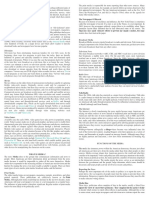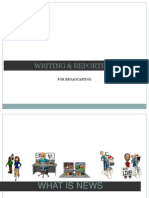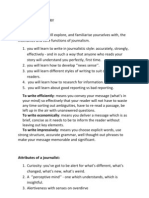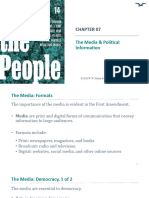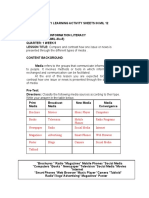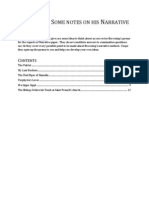TOPIC 3
NEWS MEDIA
Introduction
The news media refers to mass media outlets that provide news to the public, such as news
agencies, newspapers, news magazines, and TV news channels. The first forms of news
circulation appeared in Renaissance Europe, where handwritten newsletters were shared
among merchants. These newsletters covered topics like wars, economic conditions, and
social customs. However, these newsletters were rare and unique since they were hand-
written.
Everything changed in 1440 with the invention of the printing press by Johannes Gutenberg.
This made it possible to mass-produce newspapers cheaply using movable type and ink. By
the late 1400s, the first printed news appeared in German pamphlets, often sensationalized.
The first English-language newspaper, The Weekly News, was published in London in 1621,
followed by others in the 1640s and 1650s. In 1690, the first American newspaper was
published in Boston by Richard Pierce and Benjamin Harris, but it was quickly shut down
because it didn't have government approval.
Objectives
By the end of this topic, learners should be able to:
1. Define news media.
2. Identify and differentiate different type of news media.
3. Discuss the process of creating newspaper story.
3.1 Broadcasting
Broadcasting refers to the distribution of audio and video signals to a large audience, either to
the public or a specific group. This is a major part of mass media, with television and radio
programs being broadcast through radio, cable, or digital services. Broadcasting can include
subscription channels and pay-per-view services, where content is decoded in homes.
Broadcasting is organized in a schedule, where programs are shown at specific times. A
broadcaster may air multiple programs at once on different channels, or share a channel with
other organizations.
Television and News Broadcasting
In television news, news anchors (also called news analysts or newscasters) present news
stories, which are gathered from various sources. They deliver the news through live or
recorded footage, including reports from on-the-scene correspondents.
16
� News stories can vary in length, from short clips lasting just a few minutes to longer
documentaries that explore topics in more detail. News formats include different ways of
presenting information, such as:
• AVO (Anchor Voice Over): A short news story where the anchor reads a brief script while
visuals are shown. This typically lasts 30 to 40 seconds.
• AVO Byte: Similar to AVO, but after the anchor reads the script, a short video clip (or
"byte") is played.
• Pkg (Package): A more detailed story with three parts: an anchor introduction, a voiceover
narration, and a sign-off to end the segment.
Each format is used depending on the length and importance of the news story.
3.2 Newspapers
A newspaper is a printed publication, usually on cheap paper called newsprint, that shares
news on various topics. Newspapers can be general-interest, covering things like politics,
crime, business, sports, and opinions, or they can focus on specific topics. They can be
published daily, weekly, or at other regular intervals.
Most newspapers include stories, photos, comics, and sometimes puzzles. They may also
provide weather updates and forecasts.
Print Journalism
In print journalism, a "story" refers to an article about a specific event or topic. Journalists (or
reporters) gather and write stories about news happening locally or internationally. Many
reporters work remotely and file their stories electronically. Breaking news stories are often
written quickly by staff members, based on information gathered by reporters on the scene.
Some journalists also offer opinions or analysis in columns. These journalists are called
commentators or columnists.
The process of creating a newspaper story involves reporters gathering information
(sometimes through interviews or photos), organizing the material, and writing the story.
Then, editors review and refine the story, deciding on the headline and making any necessary
changes. Finally, the stories are arranged in the newspaper layout and approved by the chief
editor before being published. Reporters are credited with a byline, which means their name
17
� is listed with the article. This process happens based on how often the newspaper is published,
whether it's daily, weekly, or monthly.
3.3 Newsmagazines
A newsmagazine is a typically weekly publication that covers current events. Unlike
newspapers, newsmagazines often dive deeper into stories, providing readers with more
context and background about important events rather than just the basic facts. For example,
TIME is a well-known weekly newsmagazine based in New York City, known for its in-depth
articles on topics like politics, science, and global events. With an audience of 100 million
people, TIME has built a reputation for trust and authority in journalism.
3.4 Newsreels
A newsreel was a short documentary film featuring news stories, commonly shown in theaters
in the first half of the 20th century. Created by Pathé Frères in France in 1908, newsreels
were widely shown in North America, the UK, and Commonwealth countries like Canada,
Australia, and New Zealand. They remained popular in European cinemas from the silent era
until the 1960s, when television news began to replace them. As TV news took over, the
popularity of newsreels declined and they eventually disappeared.
3.5 Online Journalism
Online journalism, also known as digital journalism, refers to the reporting of news through
the Internet. The rise of the Internet has made it easier for both professional journalists and
everyday people to publish news. News stories can be published by traditional media outlets
on their websites or by individuals through blogs, social media, and vlogs.
3.6 News Coverage
Media shapes how society views culture, politics, weather, sports, and events. In recent years,
entertainment has become the most common focus of news, especially with the rise of social
media. For example, in 2006, Robert F. Kennedy Jr.'s article about the 2004 U.S. presidential
election was ignored by mainstream media until a week later when the Seattle Post-
Intelligencer picked it up.
During the 2008 Mumbai attacks, social media tools like Twitter and Flickr played a key role
in spreading news faster than traditional media, although some outlets were criticized for not
verifying the information properly. This has led to growing distrust of the media in many
countries.
18
�Social Media
More people are getting their news from social media. A 2024 Pew Research survey found
that 54% of U.S. adults turn to social media for news, with Facebook and YouTube being the
most popular sources. Social media platforms offer more than just news—they also provide
a sense of community, as people connect through groups and pages. Social media news is
appreciated for its speed, variety, and accessibility.
Social media algorithms cater to users’ interests, often showing news that aligns with their
beliefs. This has led to the rise of "news influencers," individuals with large followings who
post about news or social issues. About 37% of U.S. adults under 30 regularly follow news
influencers. People enjoy getting news that fits their views and helps them understand events
better.
19














